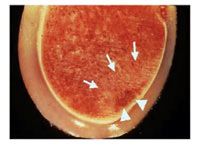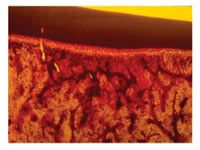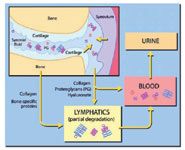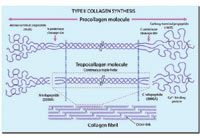Using serum biomarkers to detect early change in joint tissues in horses
Osteoarthritis is a common problem for the athletic horse and has been estimated to cause 60 percent of lameness cases in the athletic horse.
Osteoarthritis is a common problem for the athletic horse and has been estimated to cause 60 percent of lameness cases in the athletic horse.

Figure 1: Post-mortem sample from leg opposite to that suffering catastrophic injury in a racehorse. Although there is intact articular cartilage, subchondral bone necrosis and sclerosis can be visualized. Courtesy of Norrdin RW, Kawcak CE, Capwell BA, McIlwraith CW. Subchondral bone failure in an equine model of overload arthrosis. Bone 1999:22;133-139.
The osteoarthritic joint is characterized by damage to, and loss of, articular cartilage matrix components, along with reduced joint function. Early discussion on osteoarthritis (OA) in the horse extrapolated from human medicine, where it was considered that OA was a disease involving primary degradation in the articular cartilage and that all other events were secondary to this process. It is now clear that the sequence of events in equine OA is variable, but synovial membrane, fibrous joint capsule, articular cartilage, subchondral bone and intra-articular ligaments can all be involved in primary and/or secondary roles.
Most equine joint lesions probably are induced by acute trauma, repetitive load or overload. The inflammatory reaction in the synovial membrane and capsule, and any alteration in the dynamic equilibrium between biosynthesis and degradation of cartilage extracellular matrix (ECM) have been implicated in the pathogenesis of OA.
The inflammatory process results in increased levels of inflammatory mediators, and release of different macromolecules and their fragments into synovial fluid and serum follow the anabolic and catabolic processes in the articular cartilage.
Because the biochemical alterations caused by OA involve dynamic processes within all elements that constitute the joint, these mediators and products of tissue metabolism do not originate solely from the cartilage or the synovial membrane, but also from subchondral bone.

Figure 2: Microdamage with (A) micro-crack formation and (B and C) osteocyte necrosis in samples from subchondral bone from a horse exercised on pasture (B) and on a treadmill (C). Courtesy of Dr. C.E. Kawcak.
Clinical examination and radiographic imaging still are the most commonly used techniques for diagnosis of osteochondral disease, yet osteochondral damage seen during arthroscopic surgery is usually more severe than that seen on radiographs. It is the author's opinion that there usually is a good correlation between the severity of clinical signs (principally lameness and synovial effusion) and the amount of damage or disease found at arthroscopy of joints.
However, in humans, although the most common complaint of a patient with OA is pain, only about half the patients with radiographic OA have symptoms (Hochberg et al., 1989). The reason(s) that these have or do not have pain is not always clear because only some causes of pain have been studied (Altman and Dean, 1989). There is no "diagnostic test" for OA in man (Altman, 1997), but focus on MRI and biomarkers for diagnosis has occurred in recent years.

Figure 3: Principle of biomarker release from articular cartilage, bone and synovial membrane into synovial fluid, lymphatics, blood and urine.
Problem for racing industry
Of equal importance and certainly of more importance from an equine welfare perspective is the common occurrence of intra-articular fractures, many of which can be catastrophic. These fractures continue to be a serious problem for the horse racing industry, as both a significant cause of fatality and a common cause of days lost from training.
Not only is primary disease of the subchondral bone an important part of the osteoarthritic cascade (as mentioned previously), but it is also the initial event in pathologic fracture development at the level of the subchondral bone (most catastrophic fractures are intra-articular fractures in the metacarpophalangeal joint).
Work at the Orthopaedic Research Center at Colorado State University by Dr. Chris Kawcak demonstrated that microdamage in the subchondral bone can develop early when horses are subjected to athletic exercise on the treadmill.
In addition, post-mortem examination of racehorse joints at CSU (euthanized for catastrophic injury in another limb), has revealed a range of bone decrease, including microfractures, diffuse microdamage and primary osteocytic death. Figure 1 illustrates a sample from a horse euthanized because of catastrophic injury in the other limb. This incidental finding at post-mortem showed the presence of subchondral bone necrosis, with a peripheral area of sclerosis under intact cartilage in the distal palmar area of the metacarpus. Figure 2 shows microdamage and osteocyte necrosis that can occur early in association with exercise.
The ability to identify horses at increased risk of fracture before injury could be of considerable benefit, as it would allow early intervention aimed at preventing injury, e.g. by modification of a horse's training regimen.
Early identification helpful
Similarly, early identification of biochemical degradation in the ECM of articular cartilage that precedes morphologic damage could lead to early and effective treatment with prevention of, or decrease in, the articular cartilage degradation of OA.
Equine veterinarians also need objective outcome parameters in assessing the results of various treatments for musculoskeletal disease in general and joint disease in particular in the horse.
There is good potential that serum biomarkers could be an important addition to the equine veterinarian's armamentarium for all these issues.
Human clinical trials are now specific about the recording of outcome measures. Outcome variables in OA clinical trials need to be selected on the basis of the therapeutic objective and are a critical part of assessing the results of medication.
In a workshop of the World Health Organization and the American Academy for Orthopedic Surgeons, the methods to assess progression of OA of the hip and knee were reviewed (Dieppe et al., 1994). In addition, the European Group for the Respect of Ethics and Excellence in Science made recommendations on methods for registration of drugs for OA (Group for the Respect of Ethics and Excellence in Science, 1996).
Principles of biomarkers
The terms biomarker, biochemical marker and molecular marker all have been used to describe direct or indirect indicators of musculoskeletal turnover. These markers often are molecules that are typical products and by-products of the metabolic process occurring within the musculoskeletal system.
Disease alterations occur between the anabolic and catabolic processes within the skeletal tissues; consequently, concentration of biomarkers may increase or decrease. In joint disease, these molecules can be released into the synovial fluid when the source is articular cartilage, menisci, ligament or synovial membrane. If the underlying subchondral bone is involved, molecules from osseous tissue usually will be delivered into the bloodstream.
Biomarkers potentially can be used to clarify pathobiological processes in the joint, differentiate diagnostically between affected and non-affected joints, distinguish the degree of degradation in articular cartilage and monitor the response to therapy.
Direct biomarkers originate principally from cartilaginous structures and provide specific information about alterations in cartilage matrix and anabolism or catabolism.
Until now, direct biomarkers have been immunologic-based tests (ELISA or IRA), as illustrated in Figure 3. These biomarkers can reflect anabolic processes (that often are reflective of early damage and a response from the host tissue) or catabolic processes.
On the other hand, indirect biomarkers are not derived principally from cartilage but have the potential to influence the metabolism of chondrocytes or the integrity of the matrix and include proteolytic enzymes and their inhibitors, growth factors, pro-inflammatory cytokines and other molecules from non-cartilaginous sources, including MMPs, aggrecanase, TIMP, IGF-1, IL-1, IL-6, TNFa, HA and C-reactive protein.
Individual direct biomarkers of cartilage metabolism: Biomarkers of anabolic processes
The carboxypropeptide of Type-II collagen (CPII) is a useful measure of Type-II collagen synthesis (Figure 4). Although CPII concentrations were not notably higher in synovial fluid samples of joints with osteochondral fragmentation, their concentrations were significantly higher in the serum of horses with osteochondral fragmentation in the first biomarker study done at CSU.

Figure 4: Diagram illustrating production of collagen propeptide molecule against which the CPII antibody reacts.
In the same study, the concentration of epitope 846 (CS-846), another anabolic marker (of chondroitin sulfate) was significantly higher in both synovial fluids of joints with osteochondral fragmentation and the serum levels were also significantly higher.
The net result of this study was that using the combination of serum (CS-846) and CPII concentrations allowed 79 percent of horses to be correctly classified as having osteochondral damage.
It has been shown in a study in Canada that repeated use of intra-articular methylprednisolone acetate leads to a potentially harmful inhibition of CPII synthesis and an increased release of degradation products of aggrecan from the articular cartilage.
Biomarkers of catabolic processes
Measuring the degradation of Type-II collagen with biomarkers has proven to be a benefit in monitoring OA and OCD in the horse. Antibodies have been developed to identify Type-II collagen fragments that have been cleaved and/or denatured, exposing previously inaccessible regions (neoepitopes) of the molecule (Figure 5).

Figure 5: Diagram illustrating exposure of a collagen degradation epitope as exposed with breakdown of the triple helix.
Using these antibodies, notable increases in concentrations of degraded Type-II collagen have been demonstrated in synovial fluid and serum samples from horses, dogs and rabbits with experimental OA.
Initially, the Col-2–3/4short immunoassay for detecting collagenase-cleaved collagen fragments (detect both Type-I and -II collagen degradation) was developed. This assay had been used in the author's laboratory for monitoring collagenase-induced collagen degradation and to measure the inhibitory effect of a synthetic MMP inhibitor on IL-1-induced degradation of equine articular cartilage explants.
More recently, a collagen degradation immunoassay that is specific for Type-II collagen degradation and is equine specific was developed (called 234CEQ).
In a study of skeletal markers in osteochondrosis (OC) in foals done at CSU in collaboration with Utrecht University in Holland, a combination of notably higher serum concentrations of CPII, higher concentrations of Col-2–3/4short and lower concentrations of 234CEQ correlated with high OC scores (radiographically).
This study suggests that there is increased collagen turnover in OC, and by measuring the serum amounts of specific biomarkers of collagen metabolism, it was possible to identify horses with OC.
An earlier study in Canada in cases of OC found that there were notably higher concentrations of CPII and lower concentrations of CS-846 and keratan sulfate (KS) epitopes in synovial fluids of affected (compared to non-affected) typical joints.
Other biomarkers that have been measured in the horse include KS and cartilage oligomeric matrix protein (COMP), but up until now, these have proven less useful.
On the other hand, development of monoclonal antibodies that distinguish the two different sites of aggrecan degradation can help identify which mediator is the most responsible for aggrecan degradation in the horse. Aggrecanase appears more important than stromelysin in this degradation process and serves as an example how biomarkers can be used to define pathogenesis and disease targets.
Individual direct biomarkers of bone metabolism: Biomarkers of anabolic processes
During typical Type-I collagen synthesis, as with Type-II collagen, cleavage of carboxy-and amino-terminal propeptides (PICP and PINP, respectively) of the procollagen molecule occurs, and these cleaved propeptide fragments can be exploited as markers reflective of bone formation.
In a preliminary study in the United Kingdom, PICP was shown to have potential value as a molecular marker for monitoring changes in matrix turnover after tendon injury, and increases in PICP with age and exercise also have been demonstrated.
Osteocalcin is a small, non-collagenous protein associated with bone assembly and turnover. Concentrations in the horse appear to vary with age, administration of corticosteroids and general anesthesia.
In a study in our laboratory where various serum markers were used to differentiate changes with exercise from pathologic change in joints, concentrations of osteocalcin and CS-846 provided the best correlation to the modified Mankin score (r2 = 0.72) and clinical degree of pain (r2 = 0.70) using multivariate linear regression (step-wise model selection).
Bone-specific alkaline phosphatase (BAP) is expressed at high concentrations on the cell surface in bone, forming osteoblasts. In a study with treadmill exercise in young horses, serum BAP amounts were not different between exercise and control groups, although previously there had been a suggestion that there was a correlation between amounts of BAP and the amount of arthroscopically defined joint damage.
Biomarkers of catabolic processes
The release of a fragment of the Type-I collagen non-helical telopeptide (ICTP), which includes the collagen cross-linking region, has been evaluated as a marker of bone resorption in humans (Garnero et al., 1999). Concentrations of ICTP in the horse have not been shown of value in detecting pathological processes in another study conducted in the United Kingdom.
Although Type-I collagen C-telopeptide (CTX-1) has been useful in identifying bone resorption in humans, in the CSU horse OA model, CTX was less useful than CS846, CPII and GAG biomarker concentrations in predicting whether a horse was from a control, exercised or an osteoarthritic horse.
Other work in our laboratory has identified CPII and CTX-1 as potential serum indicators of the exercise effects on the developing skeletal system in young horses. Higher serum concentrations of CTX-1 and lower concentrations of CPII were found in trained foals compared to other groups, but these differences later disappeared during an additional six months of identical exercise (Billinghurst et al., 2003).
Predicting fractures
One of the latest principal aims of biomarker research at CSU has been to diagnose early subchondral bone disease and thereby potentially predict fracture. This was the basis of a study funded by the Grayson-Jockey Club Foundation and carried out with racing Thoroughbreds in Southern California.
Monthly lameness examinations and serum collections were performed in 238 2- and 3-year old Thoroughbred racehorses. Exit criteria were lack of training for greater than 30 days or completion of 10 study months. Horses with solitary musculoskeletal injuries and completion of greater than two months were analyzed and compared to aged matches, sex-matched controls.
Seven biomarkers were used for examination, including serum glycosaminoglycans (GAG), Type-I and II collagen degradation (C1, 2C), Type II collagen synthesis (CPII), Type II collagen degradation (ColCEQ), aggrecan synthesis (CS846), osteocalcin (OC) as a marker of bone formation and CTX-1 of bone degradation.
Fifty-nine horses sustained a single musculoskeletal injury, and 71 acted as uninjured controls. Based on the injured horses, 16 (27 percent) sustained an intra-articular fracture, 17 (29 percent) a tendon or ligamentous injury, 7 (12 percent) a stress fracture and 19 (32 percent) were diagnosed with dorsal metacarpal disease (DMD).
Control population showed a longitudinal increase in GAG and a decrease in OC. Horses with intra-articular fractures showed a decrease in CS846 and an increase in OC and CTX compared to the control population. Horses with tendon or ligamentous injuries demonstrated a decrease in GAG and an increase in CTX1 when compared to the control population. Horses diagnosed with stress fractures showed an increase in CTX when compared to the control population, and horses with dorsometacarpal disease demonstrated a decrease in CS846 and GAG, as well as an increase in OC and CTX1.
The greatest change in biomarker levels appeared to be four to six months prior to injury.
This study is the first step toward development of a biomarker screening platform that can be used to identify horses at risk for fracture.
New forms of biomarkers
Gene-chip microarray is the latest advance in biomarkers and represents a molecular approach to defining a disease process. The principle is to have an array of a large number of gene sequences (cDNAs) on a computer chip. The entire equine genome is currently available, and gene chips for microarray have been developed. The production of such chips facilitates the simultaneous relative quantitation of multiple mRNAs and allows for comprehensive assessment of expression amounts.
In recent work from our laboratory, the potential usefulness of gene-chip microarray as a diagnostic tool in OA has been explored. Blood samples were taken during the development of experimental OA (using the carpal chip fragment exercise model) in the horse, and we were able to identify notable upregulation of 18 different genes in the OA group compared to the controls.
This change in gene expression started early in the development of the osteoarthritic disease process. It is envisioned that this ability will be combined with conventional immunologic biomarkers (previously discussed) to provide a diagnostic platform for OA and other diseases.
Other options being explored as biomarkers include proteonomics and metabolomics.
Dr. McIlwraith is University Distinguished Professor of Surgery, Barbara Cox Anthony University Chair and director of the Orthopaedic Research at Colorado State University.